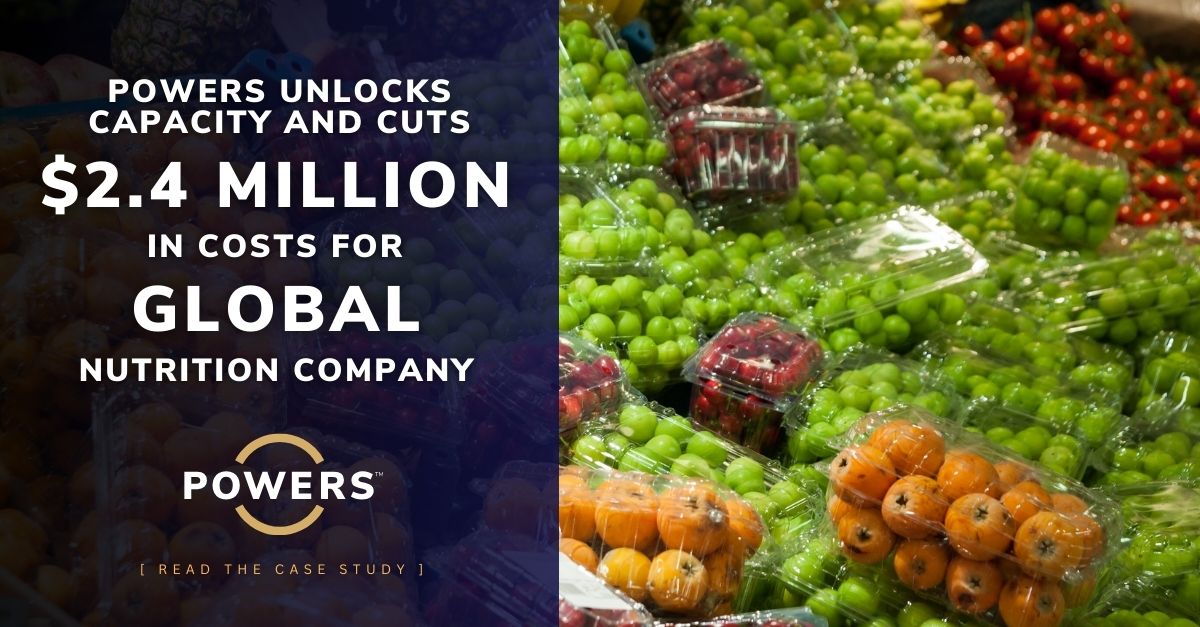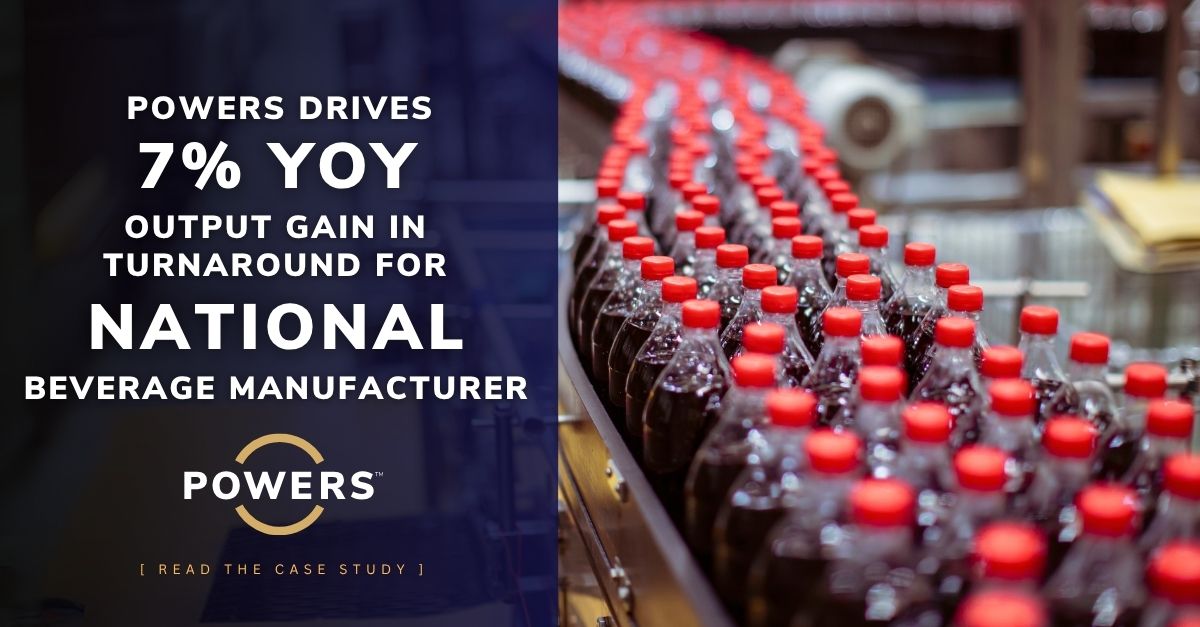
POWERS Leads Operations, Maintenance, Planning, and Inventory Control Turnaround at Major Beverage Industry Manufacturer
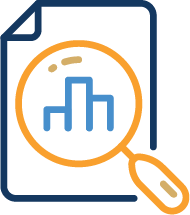
Project Overview
A major third-party beverage manufacturer running two plants was falling behind, fast. While customer demand was projected to rise by 31%, production capacity was slipping in the opposite direction. Utilization had dropped from a historical average of 70% down to 30–40%, with severe unplanned downtime, ongoing labor shortages, and poor visibility into raw material availability.
The plant lacked standard processes, didn’t track performance in real time, and struggled with basic coordination between operations, maintenance, and planning. Leadership recognized that their internal efforts weren’t enough. They brought in POWERS to help rebuild from the ground up.
What We Found
When we stepped in, operations were being held together with guesswork and outdated habits. Some of the biggest problems included:
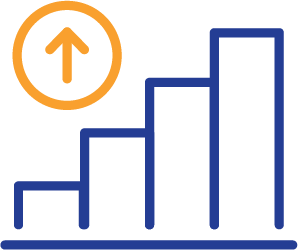
Production Improvements
- 7% YOY gain in overall plant equivalent cases
- 30% improvement in Clean in Place (CIP) times
- 30% reduction in startup delays
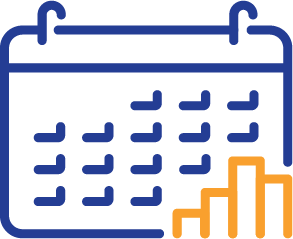
Maintenance Improvements
- 120% increase in maintenance work order execution to schedule
- 30% increase in mechanic utilization
- 39% reduction in mechanic overtime percentage

Logistics Improvements
- 44% improvement in inventory accuracy
- 100% pass rate of internal inventory audits
- 80% reduction in refrigerated truck wait times
- Unstructured Changeovers: No Centerline settings. Operators relied on memory and personal experience to stabilize the line, often wasting hours across shift changes just to reach full production speed.
- Inefficient Clean in Place (CIP): No defined steps or time targets. Extended CIP durations ate into available production hours but were still marked as “planned downtime,” masking the problem in reporting.
- Lack of Daily Visibility: No consistent metrics, visual tools, or structured meetings. There were no clear roles, follow-up routines, or escalation paths when things went wrong.
- Reactive Maintenance: Mechanics had no daily work plan. PMs were routinely skipped. Equipment issues lingered far too long, with no coordination between maintenance and production schedules.
- Inventory Gaps: Low material location accuracy (23%). Daily shortages due to poor planning. Incoming shipments were uncoordinated, arriving late or without paperwork. Freezer space was maxed out with slow-moving or retained product.
Without defined standards, clear handoffs, or real-time adjustments, the plant was stuck in firefighting mode, every shift, every day.
What POWERS Delivered
We worked side by side with plant leaders, supervisors, operators, and mechanics to bring structure to the chaos and shift the plant from reactive to proactive. Here’s what changed:
Production Systems and Front-Line Discipline
- Created Centerline standards for all major changeovers, developed with the people actually running the lines. These settings were documented, posted, and reinforced across all shifts to reduce guesswork and downtime.
- Built out CIP checklists with expected times for each step, tracked daily. Deviations are now flagged as unplanned downtime and followed up with corrective actions.
- Launched Short Interval Follow-Up routines using visual boards, shift huddles, and real-time issue tracking to close the loop on problems before they snowball.
Maintenance and Reliability Improvements
- Introduced daily work plans for mechanics, prioritizing jobs based on PM schedules and equipment data not personal judgment.
- Shifted shutdown planning from static task lists to a structured project-based approach using Gantt charts and formal pre/post reviews.
- Developed a KPI dashboard for the maintenance team, with real ownership of performance targets and follow-through.
Inventory Control and Space Management
- Overhauled receiving and locating processes, increasing material location accuracy from 23% to 88%.
- Implemented min/max controls on key ingredients and packaging materials to prevent self-inflicted shortages.
- Cleared out obsolete and held inventory, eliminating the need to rent extra freezer space.
Cross-Department Coordination
- Introduced integrated scheduling that aligns production, maintenance, CIP, and changeovers into a unified, time-based plan.
- Built a shared labor model that allows operators and techs to be flexed across lines and teams based on need, improving agility during labor shortages or absenteeism.
- Streamlined internal audits and reporting to avoid last-minute surprises and missed commitments to customers.
What Changed
With new standards, accountability systems, and leadership routines in place, the improvements came quickly and stuck.
Production Wins
- +7% year-over-year increase in total plant output (measured in equivalent cases)
- 30% faster CIP times, freeing up hours for more production
- 30% reduction in startup delays, allowing lines to reach target speeds faster and avoid missed delivery windows
Maintenance Performance
- PM completion rate increased 120% (from 40% to 88%)
- Mechanic utilization improved 65% (from 46% to 76%)
- Mechanic overtime cut 39% (from 23% to 14%)
Inventory and Planning
- Inventory accuracy jumped from 64% to 92%
- Location rate increased from 23% to 88%
- Refrigerated truck wait times reduced by 80%
- All internal inventory audits passed after repeated failures before the project
Sustaining the Gains
The key to this turnaround wasn’t just better data or smarter scheduling. It was about giving people at every level the structure, tools, and visibility to act with purpose:
- Supervisors now run daily huddles using real data and short-interval metrics
- Maintenance leads own performance targets and manage work proactively
- Planning, production, and inventory teams coordinate through shared schedules, not siloed spreadsheets
- Operators rely on documented standards not tribal knowledge to keep the lines running smoothly
This plant went from reactive and scattered to aligned and accountable.
How POWERS Can Help
If your operations are struggling with missed targets, unplanned downtime, or scheduling headaches, POWERS can help get you back in control.
We don’t bring binders. We work on the floor shoulder to shoulder with your team—to uncover bottlenecks, lock in routines, and build the right systems for daily performance. Our Digital Production System (DPS) provides the framework, but the real power is in how we help your leaders and front-line teams execute it every day.
Need to boost output, tighten up planning, or get a grip on maintenance? We’re ready when you are.

